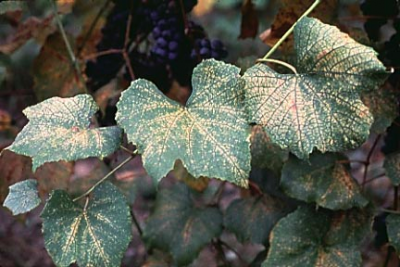(Erythroneura comes)

Introduction
The grape leafhopper is a pest of grapes in the Northeastern region of the United States and can cause serious injury to the undersides of grape leaves. It has 1 to 2 generations per year and overwinters as an adult in non-cultivated areas adjacent to vineyards, preferring dry, elevated, sheltered sites with accumulations of plant debris. Wide fluctuations in abundance between localities and from year to year are common.
Life Cycle
Leafhoppers overwinter as adults and are found in spring on basal grape leaves and weeds. The adult grape leafhopper is about 0.12 inches long and light to pale yellow with distinct dark brown and reddish markings. Eggs of the first brood are laid in epidermal tissue on the underside of the leaves in April and May and appear as a bean-shaped, blisterlike protuberance that is slightly less than 0.04 inches long.
Damage

Adults as well as immature leafhoppers feed on the underside of leaves by sucking out the liquid cell contents. The tissue surrounding the feeding puncture turns pale white and eventually dies. Feeding injury shows up first along the veins but later the whole leaf is affected. Feeding is limited initially to the lower leaves.
Grapevines can tolerate populations of up to 15 hoppers per leaf with little or no economic damage. However, heavy leafhopper feeding can result in premature leaf drop, lower sugar content, increased acid and poor color of the fruit. Ripening fruit is often smutted or stained by the sticky excrement (honeydew) of the hoppers, which affects appearance and supports the growth of sooty molds. Also, severely infested vines may be unable to produce sufficient wood the following season. Damage to the vine can be serious if infestations are allowed to persist unchecked for two or more years.
Control
The grape leafhopper has few natural enemies. Cold and wet weather conditions in spring and fall are damaging to leafhopper populations, as are wet winters. If the vineyard is accessible before budbreak and erosion is not a risk, remove weeds in vineyards and surrounding areas before vines start to grow in spring to reduce adult leafhopper populations that might disperse to new grape foliage.
When the leafhopper appears in high numbers the application of a contact insecticide may become necessary. For good leafhopper control it is important to obtain complete spray coverage of the undersides of the leaves and coverage of the fruit clusters is of secondary importance.
Despite good cultural practices, pests and diseases at times may appear. Chemical control should be used only after all other methods have failed. For pesticide information please call UConn Home and Garden Education Center or your local cooperative extension office.
The UConn Home & Garden Education Center supports UConn Extension’s mission by providing answers you can trust with research-based information and resources. For gardening questions, contact us toll-free at (877) 486-6271, visit our website at homegarden.cahnr.uconn.edu, or reach out to your local UConn Extension center at cahnr.uconn.edu/extension/locations.
Revised by the UConn Home and Garden Education Center, 2016.